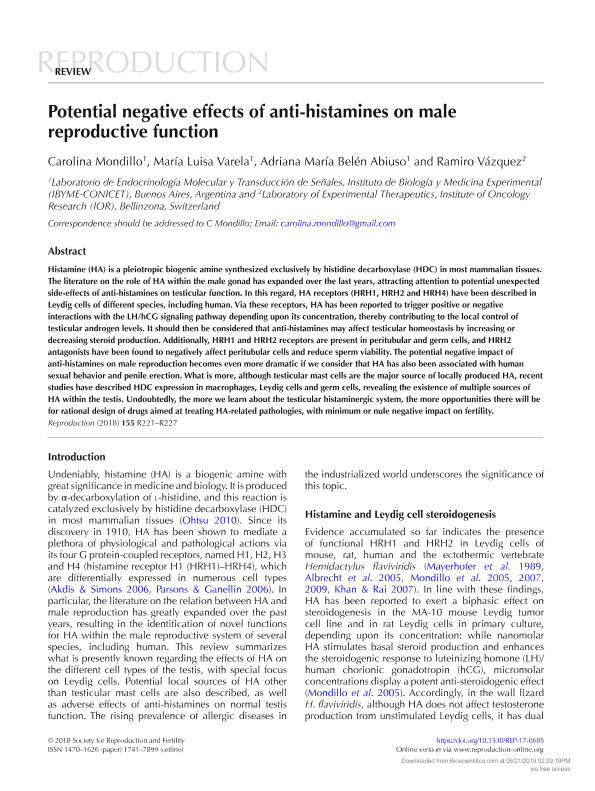Artículo
Potential negative effects of anti-histamines on male reproductive function
Fecha de publicación:
04/2018
Editorial:
BioScientifica
Revista:
Reproduction
ISSN:
1470-1626
Idioma:
Inglés
Tipo de recurso:
Artículo publicado
Clasificación temática:
Resumen
Histamine (HA) is a pleiotropic biogenic amine synthesized exclusively by histidine decarboxylase (HDC) in most mammalian tissues. The literature on the role of HA within the male gonad has expanded over the last years, attracting attention to potential unexpected side-effects of anti-histamines on testicular function. In this regard, HA receptors (HRH1, HRH2 and HRH4) have been described in Leydig cells of different species, including human. Via these receptors, HA has been reported to trigger positive or negative interactions with the LH/hCG signaling pathway depending upon its concentration, thereby contributing to the local control of testicular androgen levels. It should then be considered that anti-histamines may affect testicular homeostasis by increasing or decreasing steroid production. Additionally, HRH1 and HRH2 receptors are present in peritubular and germ cells, and HRH2 antagonists have been found to negatively affect peritubular cells and reduce sperm viability. The potential negative impact of anti-histamines on male reproduction becomes even more dramatic if we consider that HA has also been associated with human sexual behavior and penile erection. What is more, although testicular mast cells are the major source of locally produced HA, recent studies have described HDC expression in macrophages, Leydig cells and germ cells, revealing the existence of multiple sources of HA within the testis. Undoubtedly, the more we learn about the testicular histaminergic system, the more opportunities there will be for rational design of drugs aimed at treating HA-related pathologies, with minimum or nule negative impact on fertility.
Palabras clave:
HISTAMINE
,
LEYDIG CELLS
,
TESTIS
,
REPRODUCTION
,
HISTAMINE RECEPTORS
Archivos asociados
Licencia
Identificadores
Colecciones
Articulos(IBYME)
Articulos de INST.DE BIOLOGIA Y MEDICINA EXPERIMENTAL (I)
Articulos de INST.DE BIOLOGIA Y MEDICINA EXPERIMENTAL (I)
Citación
Mondillo, Carolina; Varela, María Luisa; Abiuso, Adriana María Belén; Vazquez, Ramiro; Potential negative effects of anti-histamines on male reproductive function; BioScientifica; Reproduction; 155; 5; 4-2018; R221-R227
Compartir
Altmétricas




